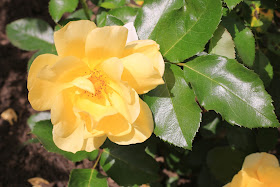In the box is a brick of Palace Ripened Pu-erh 2007 from Tevivre.com
When I first started exploring the world of tea a friend recommended
Pu-erh (Puer or Puerh) to me. She suggested I buy little bird's nest or touchas
at a local Chinese herbal shop. I was told it would help to lower my cholesterol.
Well I did start drinking it, but it felt like I was drinking dirt.
Gradually, because I told myself it was good for me, I acquired sort of a taste for dirt (it).
Then several years later I was invited to a tea tasting for Pu-erh
and my eyes were opened to the nuances and differences in a good Pu-erh
and I purchased my first bing (a solid, compressed round chunk of tea).
Yes, one Pu-erh does not mean they all taste the same.
Now I hear alot of talk about Pu-erh from tea friends, but for
some reason I haven't captured much of what there is to learn about this tea,
except to know what tastes good and what doesn't.
The tea in this photo is a bing of 2004 boiled Pu-erh from McIntosh Tea.
What I know is:
A true Pu-erh comes from Yunnan Province of China
Pu-erh is often aged
There are Raw and Ripened Pu-erh's,
now this is where it gets muddy to me.
So this post is for me as much as for you, to help get it right.
Wikipedia:
"Pǔ'ěr
tea processing,
although straightforward, is complicated by the fact that the tea
itself falls into two distinct categories: the "raw" Sheng Cha and the
"ripe" Shu Chá. All types of pu-erh tea are created from
máochá (
毛茶), a mostly
unoxidized green tea processed from a "large leaf" variety of
Camellia sinensis (C. sinensis assamica) found in the mountains of southern Yunnan.
Maocha can be sold directly to market as loose leaf tea, compressed
to produce "raw" Shēng Chá, naturally aged and matured for several years
before being compressed to also produce "raw" Shēng Chá or undergo Wo
Dui ripening for several months prior to being compressed to produce
"ripe" Shu Chá. While unaged and unprocessed, Máochá pǔ'ěr is similar to
green tea. Two subtle differences worth noting are that pǔ'ěr is not
produced from the small-leaf Chinese varietal but the broad-leaf
varietal mostly found in the southern Chinese provinces and India. The
second is that pǔ'ěr leaves are picked as one bud and 3-4 leaves whilst
green tea is picked as one bud and 1-2 leaves. This means that older
leaves contribute to the qualities of pǔ'ěr tea.
Ripened or aged raw pǔ'ěr has occasionally been mistakenly categorized as a subcategory of
black tea
due to the dark red color of its leaves and liquor. However, pǔ'ěr in
both its ripened and aged forms has undergone secondary oxidization and
fermentation caused both by organisms growing in the tea and
free-radical
oxidation, thus making it a unique type of tea. This divergence in
production style not only makes the flavor and texture of pu-erh tea
different but also results in a rather different chemical makeup of the
resulting brewed liquor."
Most often I steep my Pu-erh tea in a gaiwan such as this.
Thanks for taking the time to read this post.
I find the concept of Pu-erh to be intriguing in it's process
and aging dimensions. Often I tell friends that love coffee
that this tea would be a rich, full bodied transition into tea.
I hope sometime you give it a try.



























































